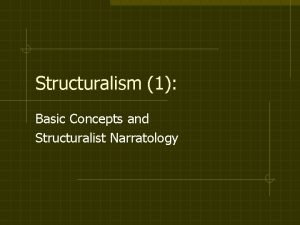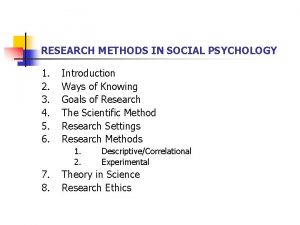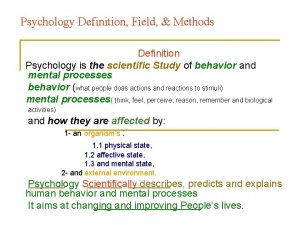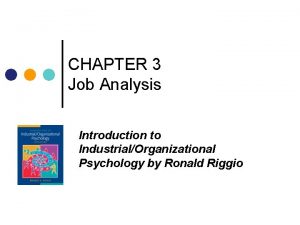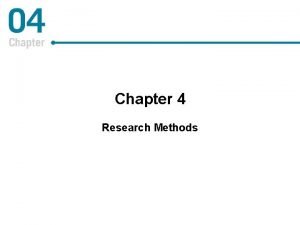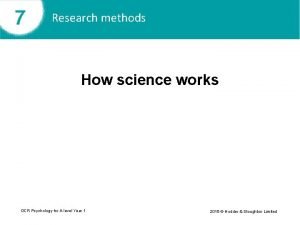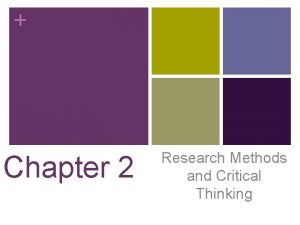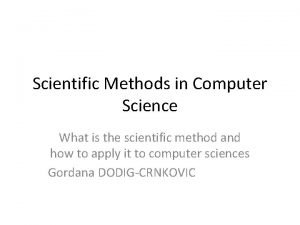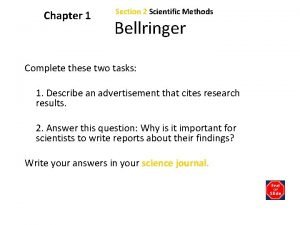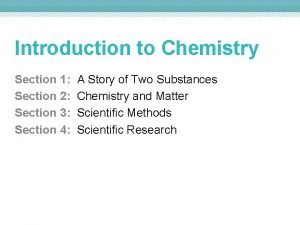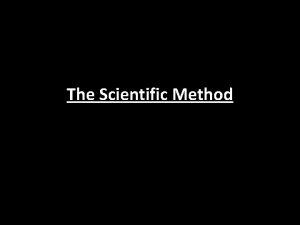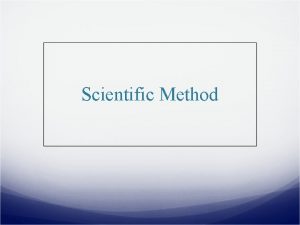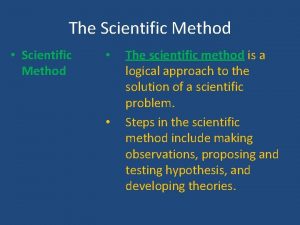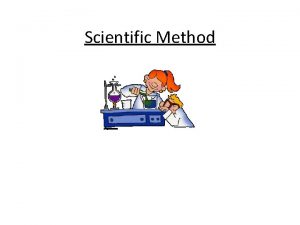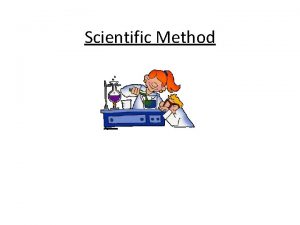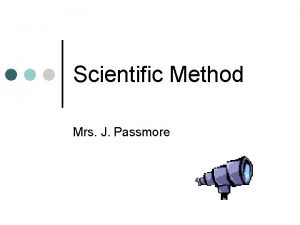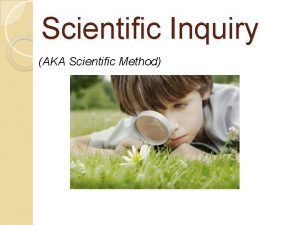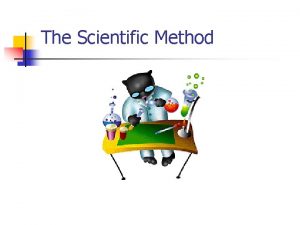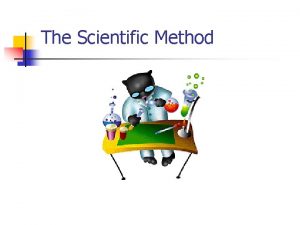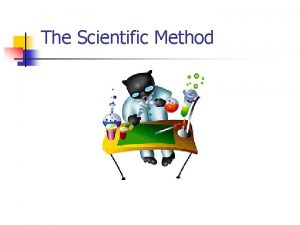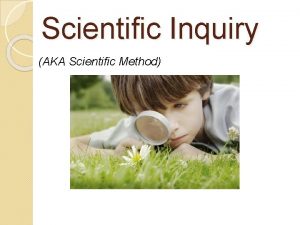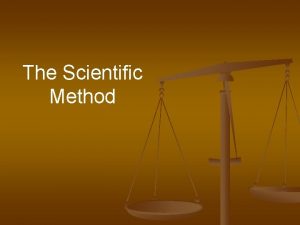Scientific Methods in Psychology Scientific Method The Scientific






















- Slides: 22

Scientific Methods in Psychology

Scientific Method

The Scientific Method: Terminology l Operational definition: A definition that specifies the operations or procedures used to produce or measure something, a way to give it a numerical value - Study: How do recreational drugs affect a person’s sense of humor? Study: Do boys show more affection toward their mothers than their fathers? Study: Does a new form of psychotherapy make people less depressed? Study: U 2 is the best rock-and-roll group ever?

The Scientific Method: Terminology l Independent Variable: The item that an experimenter changes or controls. l Dependent Variable: The item that an experimenter measures to determine how it was affected. - Study: Does exposing children to public television improve their reading skills? Study: Does wearing nametags make employees happier with their work? Study: Does being polite or rude to people make them more cooperative? Study: Does support groups for HIV+ patients increase the likelihood that they will comply with a treatment regime?

Pulling it all together: “Personal Space” l We are a Lab Group l What is our Hypothesis? How do we Operationalize “Personal Space” What is our Independent Variable? What is our Dependent Variable? l l l What are our Results? What are the Implications? http: //www. npr. org/blogs/bryantpark/2007/05/dont_stand_so_close_to_me. html

Populations & Samples Population – Entire group of individuals to be considered l Sample – Individuals within the study l l l A convenience sample is a group chosen because of its ease of availability and study. A representative sample closely resembles the population in its percentage of males and females, ethnic or racial groups, age levels, or whatever other characteristics might have some relevance to the results. A random sample is one in which every individual in the population has an equal chance of being selected. A cross-cultural sample is one that contains groups of people from at least two distinct cultures.

Types of Designs

Correlation or Causation? Figure 2. 9 A strong correlation between depression and impaired sleep does not tell us whether depression interferes with sleep, poor sleep leads to depression, or whether another problem leads to both depression and sleep problems.

Correlation or Causation? l l Finding: Women who have a baby after age 40 are more likely to live page 100. Finding: The greater the quantity of ice cream sold, the greater the number of murders. Finding: The greater the number of Churches, the greater the amount of crime. Finding: The more a person weighs, the larger his/her vocabulary.


Critical Thinking l Critical Thinking - how we utilize scientific methods in evaluating claims and theories in psychology. l l A theory that makes precise predictions is falsifiable because it is easy to think of evidence that would confirm or contradict theory. Reliance on the fewest and simplest possible assumptions is called parsimony, and is considered an essential strength of good scientific theory. Replicable results are those that anyone can obtain, at least approximately, by following the same procedures. The willingness to consider proper evidence is called openmindedness

Horoscope Study

Horoscope Study l http: //www. youtube. com/watch? v=3 Dp 2 Zqk 8 v. Hw

Statistics and Research: Drawing Conclusions l Statistics – using mathematics to organize, summarize, and interpret numerical data Descriptive statistics: organizing and summarizing data l Inferential statistics: interpreting data and drawing conclusions l

Mean, Median, Mode Mean = arithmetic average Median = score in exact center Mode = most frequently occurring

Calculate the mean, median and mode for this distribution of scores: § 2, 3, 4, 4, 7, 10

Calculate the mean, median and mode for this distribution of scores: § 2, 3, 4, 4, 7, 10

Mean, Median, Mode l 1994 baseball strike about salary: l Arguments: l Owners: Typical salary is $ 1. 2 million l Players: Typical salary is $ 415, 000 l What measure of central tendency was each side using?

Mean, Median, Mode

Correlations Correlation coefficients range from – 1. 0 to +1. 0 Sign indicates direction ( positive +, or negative - ) Number refers to the strength of the relationship ( higher = stronger ) http: //noppa 5. pc. helsinki. fi/koe/flash/corr/ch 16. html

Misleading Statistics Figure 2. 14 Why statistics can be misleading: Both of these graphs present the same data, an increase from 20 to 22 over 1 year’s time. But by ranging only from 20 to 22 (rather than from 0 to 22), graph (b) makes that increase look much more dramatic. (After Huff, 1954)

 Narratology structuralism
Narratology structuralism Information gathered during an experiment
Information gathered during an experiment Wax pattern fabrication
Wax pattern fabrication Types of sampling psychology
Types of sampling psychology Method of social psychology
Method of social psychology Research methods in developmental psychology
Research methods in developmental psychology What is field methods in psychology
What is field methods in psychology Industrial psychology jobs
Industrial psychology jobs Descriptive methods psychology
Descriptive methods psychology Research methods in abnormal psychology
Research methods in abnormal psychology Ocr psychology research methods
Ocr psychology research methods Psychology research methods worksheet answers
Psychology research methods worksheet answers Introspection psychology
Introspection psychology Symposium method of teaching
Symposium method of teaching Scientific methods in computer science
Scientific methods in computer science Scientific method bellringer
Scientific method bellringer Introduction to chemistry section 3 scientific methods
Introduction to chemistry section 3 scientific methods Hát kết hợp bộ gõ cơ thể
Hát kết hợp bộ gõ cơ thể Slidetodoc
Slidetodoc Bổ thể
Bổ thể Tỉ lệ cơ thể trẻ em
Tỉ lệ cơ thể trẻ em Voi kéo gỗ như thế nào
Voi kéo gỗ như thế nào Thang điểm glasgow
Thang điểm glasgow
